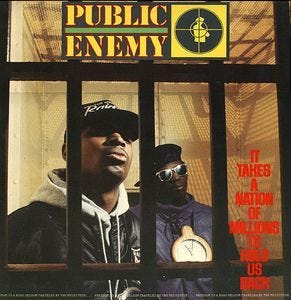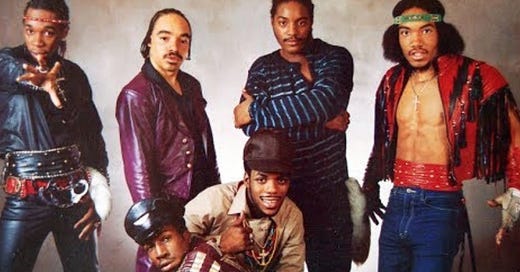My Hip Hop Love Story, Part I
This year, we are celebrating 50 years of Hip Hop culture. To commemorate, this is the first of a four-part series on Hip Hop's influence from my perspective.
The year was 1982.
I was a wide-eyed nine year old in Mississippi, listening to the radio religiously. The actual radio station, WACR 103.9 FM, was a stone’s throw from my house. Every song in rotation didn’t stand a chance at getting by me; I knew all of the song titles, artists, and the lyrics. It came naturally, really. My parents kept music around the house with a large collection of vinyl records and 8-tracks. There was a music store in Columbus, my hometown, called Bryan’s Record and Pet Center. It’s exactly how it seems; you could buy the latest 45 single as well as a parakeet at the same time.
My mother would go to Bryan’s nearly every Saturday with her latest copy of Jet magazine; she is a long time subscriber to that one and Ebony. In the back of Jet, it listed the Top 25 R&B singles and albums. She would proceed to buy every one of these singles, unless she already owned it as they were only $1. At home, we would open the wall stereo unit that she got for her Sweet Sixteen and spin the tunes. Popping her fingers and wiggling her hips while she cooked, my mother and I would have a ball cleaning up the house. My dad would be at work, but once he got home, it didn’t take much for him to start strutting through the living room like a peacock.
Ahhh, good times.
Anyway, things changed for me in 1982, musically, that is. Doing the usual, I was sitting by the radio and the deejay announced that this record was by some artists from New York City called emcees. Ok, this was Mississippi in 1982 so the deejay had to define an emcee for us slow country folks. He went into explaining the movement taking place in New York that had its own dances and music; then he formally introduced me to the word Hip Hop. Of course, in true radio fashion, the deejay had to take a break for ‘these commercial messages’ and would spin the record ‘right after this’. Then, it came into my life with full strength, bold and unapologetic. Even though it was a song that painted a bleak picture about urban life, it was a love song to me.
Grandmaster Flash and the Furious Five were my new boyfriends, especially Melle Mel. I spent every day waiting for them to come back on the radio and ‘serenade’ me with The Message. My little radio had a single cassette player and of course, I recorded the song using a blank 60-minute Memorex cassette. That, my folks, was one of the earliest forms of copyright infringement.
I used my great memorization skills and learned every word of The Message. During family and friend gatherings around the house, they would all marvel at the little nine year old rapping. I didn’t perceive it as a real skill until I turned twelve and tried my hand at writing my own rhymes; my emcee alias was Champagne and I was pretty fly, too. This would last for a few years before my rhyming evolved into straight ahead poetry. In ‘91, I was seventeen years old and Hip Hop was angry and raunchy by this time because NWA had already screamed ‘F*ck the Police’ while Too Short told so many ‘Freaky Tales’, I couldn’t keep up with them all. Public Enemy was angry too, but in a different way. Through family accounts, I had become quite familiar with Mississippi’s troubling past, so it’s not coincidental that Public Enemy, X-Clan, and KRS-ONE’s edgier, revolutionary tone appealed to me more than the jheri-curled West Coast posses, at least, not initially.


Also, by this time, I was a staunch financial supporter of Hip Hop; purchasing a cassette tape a week; sometimes two or three, depending on how much money I could get out of my daddy. My first Hip Hop purchase was DJ Jazzy Jeff and the Fresh Prince’s He’s the DJ, I’m the Rapper but the most prized possessions in my cassette collection were Eric B. and Rakim’s Paid in Full, Public Enemy’s It Takes a Nation of Millions to Hold Us Back and X-Clan’s To The East Blackwards. When I finally switched over to purchasing CDs in the early 90s, I had amassed about 200-300 cassette tapes.
Hip Hop was part of my educational process because through the emcees, I learned about a world outside my slow moving hometown. Between Hip Hop and reading, I began dreaming about living beyond the borders of Mississippi and doing things other than working at the local factory, getting married and having children fresh out of high school, or having children while still in high school. It even changed the books I read; I found myself on a quest to learn about myself and my people. For instance, KRS-ONE’s Why Is That? challenged me to see black faces in the Bible.
“Genesis, chapter 11, verse 10 explains the genealogy of Shem. Shem was a Black man in Africa. If you repeat this fact, they can’t laugh at ya.” — KRS-One, Why is That?
From there, I began wondering if black people were a part of something else besides slavery; which was all I learned in American History classes. I knew something was there because the teachers managed to find some black people during Black History Month, but I wanted to know if I could learn about black people all year long. Believe it or not, I credit Hip Hop for this spirit of self-discovery; as a matter of fact, my childhood would have been rather dismal if it wasn’t for Hip Hop. I even chose my boyfriends based on their love for the music and culture; turning my nose up at any boy who didn’t know the latest dance steps, heard the latest joints, saw the latest videos on Rap City and Yo! MTV Raps, wasn’t sporting a high top fade and hadn’t watched Krush Groove, Breakin’ 1 & 2, Beat Street, and Wild Style. Yo, word up, he was wack!
By the time I went to college, I was a certified B-Girl, at least in my eyes, anyway. Throughout my years in undergrad, Hip Hop was my foundation; the music was the soundtrack to my life. The Resident Assistants in the dorms where I lived would bang on the door to check me for playing my music too loud but that was the only way to feel it. From graduation in 1996 to about 2000, I was still holding strong to my core Hip Hop values. But Hip Hop had climbed up a steep hill and started spiraling on the down side. The Dirty South was finally getting some real attention through groups like OutKast and Goodie Mob (which I will address in another article) but a lot of the music was growing weak through commercialization and record executive manipulation. I noticed that I was getting frustrated; but I was able to comfort myself with Nas’ Illmatic, and Common’s Like Water for Chocolate. I was also able to get a bit of Cell Therapy from the Goodie Mob and hang out with ‘Two Dope Boys and a Cadillac’. But, deep down inside, I saw it coming—Hip Hop was on the verge of declining—and in some ways, began dying a slow death.
End of Part I.
Next Up: Part II of My Hip Hop Love Story plus a special tribute to Rakim, the God MC.







Nice piece. I envy people who listened to music with their parents. It always sounds so cool!!